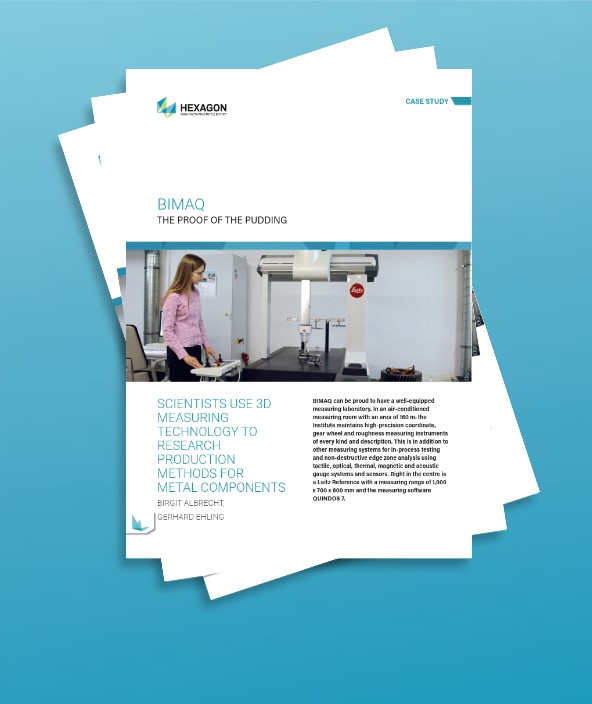Scientists use 3D measuring technology to research production methods for metal components
BIMAQ - Germany
Contact us

Generally speaking, the city of Bremen is known for its famous Town Musicians. However, passionate engineers know that Distortion Engineering is the new brand of this Hanseatic City. The term was coined by the University of Bremen where in 2001 the special research programme 570 was created with the same name, which attracts funding from the German Research Foundation (DFG). The Bremen Institute for Metrology, Automation and Quality Science (BIMAQ) takes an active part in the programme. The Institute uses a Leitz Reference to try and find out the causes of distortion in typical automotive components. Another BIMAQ project is dedicated to wind power: it is intended that measurements of largevolume gear components provide valuable information for production optimisation.
BIMAQ can be proud to have a well-equipped measuring laboratory. In an air-conditioned measuring room with an area of 160 m2 the Institute maintains high-precision coordinate, gear wheel and roughness measuring instruments of every kind and description. This is in addition to other measuring systems for in-process testing and non-destructive edge zone analysis using tactile, optical, thermal, magnetic and acoustic gauge systems and sensors. Right in the centre is a Leitz Reference with a measuring range of 1,000 x 700 x 600 mm and the measuring software QUINDOS 7.
BIMAQ can be proud to have a well-equipped measuring laboratory. In an air-conditioned measuring room with an area of 160 m2 the Institute maintains high-precision coordinate, gear wheel and roughness measuring instruments of every kind and description. This is in addition to other measuring systems for in-process testing and non-destructive edge zone analysis using tactile, optical, thermal, magnetic and acoustic gauge systems and sensors. Right in the centre is a Leitz Reference with a measuring range of 1,000 x 700 x 600 mm and the measuring software QUINDOS 7.
Test objects: typical automotive gear wheel teeth
Scientists use the CMM for detailed studies of distortions of typical automotive gear wheel teeth. „The Collaborative Research Centre for Distortion Engineering was formed in 2001. We are now in the last of three phases and are now turning our attention to gear wheel teeth“, says Head of the Institute Prof. Dr.-Ing. Gert Goch. „We assume that distortion is the result of several interacting processes. For this reason we are studying the whole production chain of gear teeth wheels - each step, from the cast to soft gear machining through to grinding.“ The tests involve measuring 1,800 gear wheels which each represent a certain status in the multi-step production process. They were all made from the same batch of steel, they all have a diameter of 120 mm and a hole with a diameter of 45 mm. The Institute for Material Technology supports the BIMAQ in its venture. It has the necessary equipment and expertise to produce these gear wheels. The ‚history‘ of the wheels is documented very carefully and stored in a database. In this way staff in the measuring laboratory can find out exactly at what point in production distortion occurs.
We measure the gear wheels as accurately and comprehensively as possible in accordance with the test plans“, says Martina Fuhrmann who is a member of the BIMAQ research staff. The Leitz Reference records 750 measuring points per second, the volumetric deviation of longitudinal measurement of the coordinate measuring machine is 0.9 + L/350 μm – a good starting point for the scientists‘ work. „We use high-speed scanning to record a large number of measuring points on the gear wheels. We measure 9 x 3 lines on all teeth in order to plot the topography of the tooth profile. We apply the same meticulous approach to the face of the gear wheel. At the end we obtain a complete description of the object. We evaluate the measured points as comprehensively as possible and determine any deviations and distortion in this way. In a further step we can then develop new strategies for the production and measuring of gear wheel teeth.“
We measure the gear wheels as accurately and comprehensively as possible in accordance with the test plans“, says Martina Fuhrmann who is a member of the BIMAQ research staff. The Leitz Reference records 750 measuring points per second, the volumetric deviation of longitudinal measurement of the coordinate measuring machine is 0.9 + L/350 μm – a good starting point for the scientists‘ work. „We use high-speed scanning to record a large number of measuring points on the gear wheels. We measure 9 x 3 lines on all teeth in order to plot the topography of the tooth profile. We apply the same meticulous approach to the face of the gear wheel. At the end we obtain a complete description of the object. We evaluate the measured points as comprehensively as possible and determine any deviations and distortion in this way. In a further step we can then develop new strategies for the production and measuring of gear wheel teeth.“
Vision of the future: stronger gear components for wind power
Although this project is still in the initial phase, the team uses the Leitz Reference to explore new and promising areas. The production of large gear boxes for wind energy plants offers an enormous potential for improvements. These plants are designed for an operating life of 20 years. However, most gear boxes have to be replaced earlier, some as early as six years after installation. Besides it is difficult to obtain spare parts. The order books of manufacturers are full to bursting and the delivery times accordingly long.
It is therefore no surprise that plant operators make enquiries to the Institute regarding measuring on commission basis. „If a fault is suspected on the planet gear, it is likely that we are called in. The construction drawings are impossible to obtain. So in order to reconstruct the design of the planet gear, the plant operators have to resort to reverse engineering. With the Leitz Reference and the measuring software QUINDOS 7, which is particularly suitable for gear wheel teeth, we can measure components up to a certain diameter.“ Using a planet gear wheel with a diameter of 530 mm, BIMAQ has delivered proof that it masters the measuring of unknown geometries. The wheel had score marks and had to be replaced as soon as possible. The scientists used the Leitz Reference and the QUINDOS 7 measuring software to measure various parameters, such as the reference diameter, profile shape, pressure and helix angle in order to establish the geometry of the gear wheel.
In view of the enormous maintenance costs, plant operators push for an improvement in the gearbox quality so that the frequency of failures can be reduced. For the BIMAQ the following questions are relevant: how can useful measurements be carried out on large cylinder wheels, under industrial aspects, which make it possible to predict the functional characteristics and service life of such a toothed wheel? What are the causes of malfunction - apart from distortion? What measures have to be taken to allow manufacturers of large gear wheels to control and improve their production process? It is hoped that answers will be supplied by a coordinate measuring machine of the Leitz PMM-F series with a measuring range of 2,500 x 2,000 x 700 which is designed for measuring large-volume components.
It is therefore no surprise that plant operators make enquiries to the Institute regarding measuring on commission basis. „If a fault is suspected on the planet gear, it is likely that we are called in. The construction drawings are impossible to obtain. So in order to reconstruct the design of the planet gear, the plant operators have to resort to reverse engineering. With the Leitz Reference and the measuring software QUINDOS 7, which is particularly suitable for gear wheel teeth, we can measure components up to a certain diameter.“ Using a planet gear wheel with a diameter of 530 mm, BIMAQ has delivered proof that it masters the measuring of unknown geometries. The wheel had score marks and had to be replaced as soon as possible. The scientists used the Leitz Reference and the QUINDOS 7 measuring software to measure various parameters, such as the reference diameter, profile shape, pressure and helix angle in order to establish the geometry of the gear wheel.
In view of the enormous maintenance costs, plant operators push for an improvement in the gearbox quality so that the frequency of failures can be reduced. For the BIMAQ the following questions are relevant: how can useful measurements be carried out on large cylinder wheels, under industrial aspects, which make it possible to predict the functional characteristics and service life of such a toothed wheel? What are the causes of malfunction - apart from distortion? What measures have to be taken to allow manufacturers of large gear wheels to control and improve their production process? It is hoped that answers will be supplied by a coordinate measuring machine of the Leitz PMM-F series with a measuring range of 2,500 x 2,000 x 700 which is designed for measuring large-volume components.
Highly accurate source of information: Leitz PMM-F
„As soon as the new machine has been set up in the measuring room, we can start properly with the wind power project“, says Prof. Goch. „Hexagon Metrology has worked out a concept that suits our requirements. The new machine is to be sunk into the ground. That means that the measuring table will be on the same level as the floor. The components from the wind power plants are delivered via a ramp and then transported to the Leitz PMM-F using an air cushion vehicle. That makes the handling of the components very easy.“ BIMAQ wants to use the same measuring strategy for measuring the wind power components with the Leitz PMM-F: gear wheel sets representing the whole production chain are to be measured completely. Periodically occurring geometry deviations, such as eccentricity and pitch errors will provide valuable information to the scientists.
However, conclusions regarding the causes of defects and failures of wind power stations can only be arrived at in combination with information supplied by sensors in the systems. Sensors measure the status of various physical parameters in wind power plants, such as vibrations. These data do not have enough information content. To provide this information, sensors would be needed that are capable of measuring dynamic forces, tensions and moments for periods of one or more decades. BIMAQ is also involved in the optimisation of these sensors. So there is a lot that needs to be done. With Leitz coordinate measuring machines the BIMAQ is well equipped to tackle these tasks.
However, conclusions regarding the causes of defects and failures of wind power stations can only be arrived at in combination with information supplied by sensors in the systems. Sensors measure the status of various physical parameters in wind power plants, such as vibrations. These data do not have enough information content. To provide this information, sensors would be needed that are capable of measuring dynamic forces, tensions and moments for periods of one or more decades. BIMAQ is also involved in the optimisation of these sensors. So there is a lot that needs to be done. With Leitz coordinate measuring machines the BIMAQ is well equipped to tackle these tasks.

